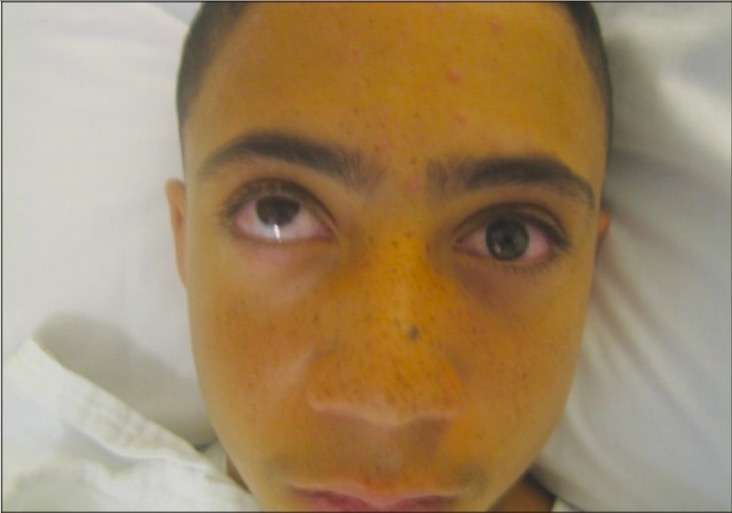Playlist
Show Playlist
Hide Playlist
Fracture of the Orbit – Traumatic Injuries
-
Slides OP Traumatic Injuries of the Eye.pdf
-
Download Lecture Overview
00:01 All right, trauma to the orbit that causes a blowout fracture. 00:06 So most orbital fractures occur, as indicated in the green box, in the posterior medial area where the bones are thinner. 00:13 Most of the rest of the orbit, lateral, superior, inferior, relatively thicker bones. 00:19 So, if there's increased pressure over the eye, it will tend to blowout in that medial canthal area. 00:26 So, in the posterior medial area. 00:29 And what is shown on the right, is just a blowout. 00:33 So you're seeing fracture of the bone with associated hemorrhage. 00:37 We haven't really ruptured the orbit. 00:39 Yes, you can, under extreme circumstances rupture the orbit, but that's not what we're talking about here. 00:45 And that's a different entity altogether. 00:47 And once that happens, it's kind of end of the game. 00:51 But we're talking about bony fractures of the orbit. 00:55 What are the consequences related to this? So pain. Yeah, got that. 00:59 Yeah, broken a bone, it hurts like crazy. 01:03 There's going to be associated inflammation, so there will be edema. 01:07 There will be ecchymosis. 01:08 Yes, you've broken lots, and lots, and lots of blood vessels, so there'll be bruising. 01:13 Of course, you have a big old black eye. 01:15 Depending on the compression of associated nerves as the bone fractures, and the associated hemorrhage compressing those nerves, you may have restricted ocular movement. 01:27 In fact, we're looking at a child who had a blowout fracture of the orbit, and now can't bring down his left eye. 01:35 So he has had some impact on his ocular motor nerve, which is going to be running primarily in that medial posterior area. 01:44 Because of the hemorrhage, you may have increased intraocular pressure that does need to be released. 01:49 Because if you have increased intraocular pressure in the same way that you can have optic atrophy or optic nerve atrophy associated say with glaucoma, increased intraocular pressure, because of hemorrhage behind the eye really needs to be addressed and you need to decompress that. 02:06 And clearly, as a result of the now, blood, or other fluids that are accumulating in various places, you may have double vision because the eyes are not appropriately aligned. 02:18 Other signs and symptoms? So this is showing another blowout fracture, this was one that would have affected the cranial nerve III, in fact, could have given the appearance of the child that you saw on the previous image. 02:34 There will be loss of sensitivity in the area because there are infraorbital nerves that are also going to be compressed. 02:40 So you may have a relative analgesia related to that. 02:44 And because the sinus cavity is right there and you can drain into the sinuses, you may have epistaxis or just literally, a bloody nose. 02:52 That also makes a lot of sense because of the proximity of the various structures around a blowout fracture. 03:00 No surgical treatment of the fracture is typically indicated unless there's entrapment of the extra ocular muscles, or increased intraocular pressure. 03:08 So, we will let the bone heal unless we have these other problems going on. 03:16 And with that, we've talked about trauma to the eye, cornea, and to the orbit.
About the Lecture
The lecture Fracture of the Orbit – Traumatic Injuries by Richard Mitchell, MD, PhD is from the course Trauma and Neoplasms of the Eye.
Included Quiz Questions
Where do orbital fractures most commonly occur?
- Posterior medial area
- Superior orbital ridge
- Inferior orbital ridge
- Lateral orbital ridge
- Orbital floor
What is a common symptom of a blowout fracture?
- Restricted ocular movement
- Myopia
- Mydriasis
- Excessive tearing
- Miosis
What causes an afferent pupillary defect in a blowout fracture?
- Damage to the cranial nerve II
- Damage to the cranial nerve I
- Damage to the cranial nerve IV
- Damage to the cranial nerve V
Customer reviews
5,0 of 5 stars
| 5 Stars |
|
5 |
| 4 Stars |
|
0 |
| 3 Stars |
|
0 |
| 2 Stars |
|
0 |
| 1 Star |
|
0 |




